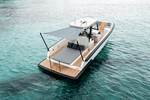Brødrene Aa delivers carbon fiber catamaran to serve as transport through the Saronic islands
The Aero 1 Highspeed, operating under Attica Group, features an aerodynamic and energy-efficient design for passengers and cargo in the Eastern Mediterranean Sea.
Brødrene Aa (Hyen, Norway) has delivered the first of the Aero catamarans, the Aero 1 Highspeed, to serve the Saronic islands in Greece. The vessel features an aerodynamic and energy-efficient design, accompanied with lightweight carbon fiber trademark construction. All Aero catamarans will operate under the flag of Attica Group (Greece), buyer of the vessels and the main provider of ferry services for passengers and cargo in the Eastern Mediterranean Sea.
Aero 1 Highspeed, at 36 meters in length and 9.7 meters wide, is the first of three Aero catamarans ordered by Attica and will be used to transport three million passengers traveling annually on Saronic routes.With a full load, it will be able to maintain a maximum speed of 32 knots, according to Brødrene Aa. The interior is designed with a focus on comfort, even in rough seas. The spacious passenger accommodation area has large windows, for a view and ample natural light. There are special provisions for the facilitation of passengers with reduced mobility and dedicated area for bicycle transportation. Its construction out of carbon fiber also contributes to a reduction of fuel consumption and air emissions.
“We are pleased and proud that our vessels will soon be sailing in the demanding Greek seas trusted by one of the largest European ferry operators,” Tor Øyvin Aa, CEO of Brødrene Aa, says.
Upon delivery of the Aero 1 Highspeed, Spiros Paschalis, CEO of Attica, adds, “In these challenging times, Attica Group remains focused on providing first class sea transport services to our passengers, with new, innovative and more environmental friendly vessels, to the benefit of our islands and their people and to the Greek tourism and economy.”
Related Content
-
Plant tour: Teijin Carbon America Inc., Greenwood, S.C., U.S.
In 2018, Teijin broke ground on a facility that is reportedly the largest capacity carbon fiber line currently in existence. The line has been fully functional for nearly two years and has plenty of room for expansion.
-
Cryo-compressed hydrogen, the best solution for storage and refueling stations?
Cryomotive’s CRYOGAS solution claims the highest storage density, lowest refueling cost and widest operating range without H2 losses while using one-fifth the carbon fiber required in compressed gas tanks.
-
Bio-based acrylonitrile for carbon fiber manufacture
The quest for a sustainable source of acrylonitrile for carbon fiber manufacture has made the leap from the lab to the market.













